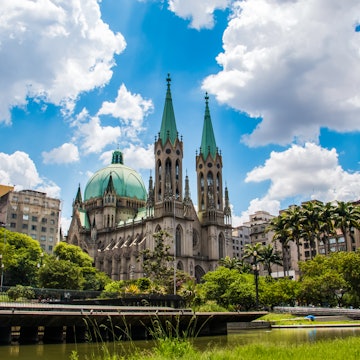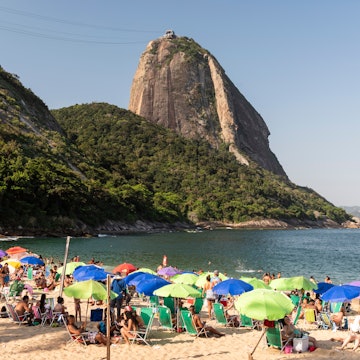

São Paulo skyline. ADVTP/Shutterstock
Because of its sheer size and sprawl, Brazil’s largest city can be intimidating for new arrivals. The skyline unrolls in every direction, a concrete jungle of high rises and highways busy with traffic. Despite being the finance, art and cultural capital of Brazil, first-time visitors may struggle to find the city’s colorful and creative enclaves.
Founded by Jesuits in the 16th century, São Paulo began as a small settlement on the Tietê River and expanded rapidly in the 19th century with the coffee boom. While the coffee barons built their mansions on Avenida Paulista, the demand for labor following the abolition of enslavement in 1888 spurred a huge wave of immigration that transformed the city's cultural identity. This context is the key to appreciating the history of São Paulo.
But the city is also focused on the future. Modern-day travelers will enjoy exploring the contemporary landscape of bohemian neighborhoods dotted with street art, fine art museums and great Brazilian cuisine. Here’s everything you need to know before your first trip to São Paulo.

When should I go to São Paulo?
For a comfortable climate the best time to visit São Paulo – and Brazil in general – is between October and November, when springtime temperatures are well-balanced between warm sunny days and cozy and cool nights. In the winter (May to September) temperatures are quite mild (15°C to 21°C/60°F to 70°F), so it’s pleasant, although most days tend to be a bit overcast. Summers (December to February) can be quite hot with highs between 27°C and 32°C (80°F to 90°F) – plus intermittent tropical downpours – so consider booking accommodations with a rooftop pool for your midday cooldown.
Event-wise, there is always something going on in São Paulo and, like all Brazilians, Paulistanos are eager to jump on any opportunity to throw a good party. Although Rio de Janeiro’s Carnaval celebrations are better known, São Paulo has its main parade in the Anhembi Sambadrome and block parties, or blocos, in every neighborhood in the city. If you miss the fun, you can find an equally colorful party during Parada do Orgulho in June, Brazil’s biggest LGBTIQ+ Pride celebration.
How much time should I spend in São Paulo?
A weekend in São Paulo is a sufficient amount of time to give you a sense of the city. If you stay on the move, you can easily hit up most of the iconic sights, like Ibirapuera Park and Batman Alley (plus a few museums) in two or three days. If you stay a week, you can do a more thorough tour of the many art museums and distinct neighborhoods like Liberdade and Vila Madalena. If you have a few more days to spare in São Paulo, consider adding on an excursion in São Paulo state to a beach town like Guarujá, which can be reached by car in under two hours.


Is it easy to get in and around São Paulo?
Some buses and a train line can take you from Guarulhos International Airport, where most international flights arrive, to the city center. The most efficient way is by taxi or a rideshare service like Uber, which is the most popular in the city. Use the public transportation system to get around the city – it includes six metro lines but does not connect all of the city’s neighborhoods, and you may have a 20 to 30 minute walk to reach your final destination.
Rideshares are the most efficient mode of transport and tend to be quite budget-friendly in São Paulo. A 20-minute ride costs around 25 to 30 Brazilian Real (R$25 to R$30). From the airport to the city center, trips start at R$100.
Top things to do in São Paulo
Explore the city through its museums
There are fantastic art museums throughout the city, with the main attractions being the MASP (Museum of Art of São Paulo) and the Pinacoteca. Head to the city’s largest park, Ibirapuera, to enjoy the green space and more museums like the Museu de Arte Contemporânea and the Museu Afro-Brasil. Or, explore the world of soccer at the Museu do Futebol, housed in the Pacaembu Stadium.
Stroll through the art-filled walls of Beco do Batman
Also known as “Batman Alley,” Beco do Batman is São Paulo’s most famous street art destination. The short street is closed to traffic so pedestrians are free to take their time and stroll amidst the many murals created by prominent artists. Explore beyond this street and you’ll find even more art all over the Vila Madalena neighborhood, where there are plenty of shops, restaurants and bars.
Discover Japanese-Brazilian culture in Liberdade
When you need a break from the heavy meat and rice dishes of Brazilian rodizio (all-you-can-eat restaurants), head to Liberdade for sushi and ramen while you explore one of the world’s largest Japanese communities outside of Japan. After stopping in the Museu Histórico da Imigração Japonesa, peruse the shops around Praça da Liberdade for a little taste of Asia in Brazil.

My favorite thing to do in São Paulo
No return to São Paulo is complete for me until I go for a walk through Beco do Batman. Since the moment the first Batman mural appeared in the 1980s, this art-covered alley has been constantly transforming and reinventing itself. As more visitors pour in year after year, the surrounding neighborhood of Vila Madalena has also blossomed into an epicenter for creatives with galleries, boutiques, and great restaurants and bars that draw a youthful crowd.
How much money do I need for São Paulo?
You may need to carry some cash around, but most places in São Paulo will accept cards. The cashier will ask you “credito or debito,” but you should answer credit even if you are paying with a foreign debit card. Some people may ask for your “PIX” but this common money transfer service is only for Brazilian bank accounts.
Hotel room: R$400 to R$1200 per night
Self-catering apartment: R$150 to R$450 per night
Museum ticket: R$20 to R$30
Public transport ticket: R$5
Coffee: R$12
Sandwich: R$13 to R$25
Beer: R$13
Caipirinha: R$20
Dinner for two: R$150 to R$300

Is São Paulo safe?
Locals are quick to advise visitors to tuck away their jewelry and leave expensive electronics at home when exploring São Paulo. Homelessness has increased significantly in the city center, particularly around the Praça de Sé area as well as Avenida Paulista, although these areas have a few worthy attractions like the lively Casa de Francisca in a small corner of the center that is being revitalized.
To stay safe at night, avoid walking alone and use Uber to get around. During the day, you will find certain neighborhoods to be quite safe but pickpocketing may be an issue if there are large crowds. Generally, you shouldn’t walk around with your phone in your hand and you should keep your belongings zipped up and tucked away at all times.














